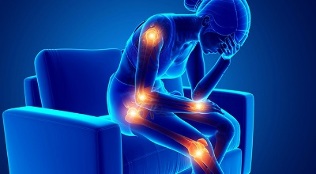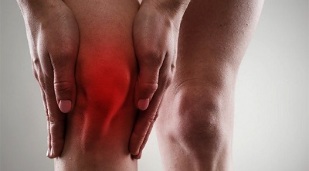Healthy joint tissues include cells that are able to recover from damage - regenerate. The bones, cartilage, synovial membrane and other components can become unhealthy. Dead, damaged cells accumulate in certain tissues. They are unable to divide, which inhibits regeneration. They are difficult to eliminate, which is a major problem in restoring joint health.
Under any physical impact, strong mechanical stress can damage cells and lead to their death. It is difficult for an already diseased joint to bear the load. It is very difficult to heal. In order to avoid disease or overcome it, it is necessary to understand the protective mechanisms of joint tissues and cells. In the area of joint damage, arthritis, arthritis, polyarthritis and other diseases are distinguished. Let's take a closer look at the difference between arthritis and dry joints.
First cause of disease
The joint is protected by a neuromuscular cushion. Thanks to the muscle contraction control system, the shock effect does not occur or is mitigated. The nervous system ensures smooth movement and distribution of the load. In a relaxed state, the muscles also stimulate small vibrations, which lead to the secretion of lubricants, eliminating dead cells.
Nerve shock impairment occurs due to poor conduction of nerve pathways. Fatigue, for example, impairs the defense of the joint. Dead cells begin to accumulate without time to expel them. The result is inflammation. The weakening of the defense will accelerate the degradation of not only the joints but also the spine.
A number of factors increase the risk of arthritis, starting with blows, bruising, overload, and hypothermia. Arthritis occurs - an inflammatory process. If it cannot be cured for many months, the deformity begins - arthritis.
What is arthritis: causes, symptoms
Can specify the reason for the appearance:
- The food is not correct.
- Bad habits: alcohol, smoking.
- Lower body temperature.
- Injured.
- Excessive stress on joints.
- Consequences of illness, infection in the past.

The disease is detected through the following symptoms:
- Swelling in the joint area, pain sensation, increased sensitivity, limited movement (ie bursitis).
- Severe pain with exercise and at rest.
- Morning stiffness due to overnight swelling. One hour after it starts, the activity will pass.
In addition to the listed signs, inflammatory symptoms may appear: weakness, sweating, chills, fever. Some have headaches, weight loss. Sometimes concurrent illnesses occur: the heart and lungs are affected.
What is joint disease: causes and symptoms
As a result of progressive arthritis, symptoms of joint disease in most cases appear only after 40 years.
The disease is characterized by the following manifestations:
- Pain does not occur in a calm state but during exertion. Discomfort occurs in the hip or knee joint when walking, using a ladder or exercising. This initial aching sensation may go away with additional movement. There is also a strong sense of pain, accompanied by a screeching sound when bent, unable to bow.
- Pain at the onset of movement after rest occurs due to the deposition on the rubbing surface of debris - the product of cartilage and bone destruction. The sensation may stop after 15 minutes as the residue is expelled.
- Dull pain at night that is caused by a blockage of the veins.
With arthritis, inflammation often occurs. Along with painful sensations, swelling is observed (as in arthritis). If symptoms of both diseases appear, then dry joints will be diagnosed.
Prolonged osteoarthritis can lead to limited mobility. In muscles and tendons, degenerative changes (spasticity) begins, and then deformation. In this case, diagnosis is made - joint deformity or degenerative joint disease.
Distinguishing the stages of the disease, identified by X-ray images, results of computed tomography:

- 1 degree- slight change in cartilage, bone. Painful swelling occurs with moderate exertion, which subside after a period of rest.
- degree 2- destroys cartilage, proliferates peripheral bone tissue in the form of bone cells. Narrow joint space, accompanied by constant pain. Puffiness also becomes stable.
- 3. 5 degrees- destroys many cartilage and bones. The swelling doesn't go away, the ligaments and muscles don't work correctly, and deformation occurs. The load shaft is disturbed in the joint.
The risk factors for joint disease are:
- Not enough mobility.
- Overweight.
- Age factor.
- Infections caused by inadequate blood and lymph flow, delayed.
Under no circumstances does tissues have time to recover during joint destruction.
The difference between osteoarthritis and osteoarthritis
Both arthritis and dry arthritis are becoming more common diseases. Diseases that affect joints have similar names. The difference lies in the nature of negative changes that occur during the onset and development of symptoms. Pain in arthritis is a consequence of an inflammation of the tissue. The synovial sac is affected, blood supply, lymph is interrupted, the disease affects the nerves. The joint is no longer eating properly, and it does not produce lubricant either. The cartilage is affected.
The disease can be observed not only in adults, but also in children (adolescent form). The injury affects any joint, even those as small as a finger, and can also cover some joints (polyarthritis).
Arthritis occurs due to prolonged arthritis. Cartilage and entire joints do not receive nutrition from the joint fluid (lubricant) for a long time. Often there are exacerbations in the form of inflammation. First, the cartilage is destroyed, like the bone's mantle, and in later stages bone tissue can be affected. Cartilage areas don't have time to regenerate, they soften. Due to the violation of sliding surfaces in the joint, pain occurs.
This disease appears after 40 years. Affects large joints (arthritis or knee arthritis), can lead to disability, disabling. Fingers (osteoarthritis) and feet are less affected. And the disease can also be observed in temporal joints, elbows, shoulder joints and other joints.
Thus, joint disease is a consequence of the development of symptoms of arthritis, transitioning to the destructive stage.
Prevention and Treatment

The lack of nutrients in cartilage and joints in arthritis should not be exacerbated by inflammation. Simultaneously with the reimbursement of foci with anti-inflammatory drugs, the cause must be eliminated. If you don't, it can turn into a joint. If both diseases are suspected, it is necessary to have an accurate diagnosis, on this disease it is necessary to consult a specialist. This is done by a rheumatologist, orthopedic trauma doctor and surgeon. It is required to visit the clinic. And in some diagnostic centers, such patients are served by a joint specialist.
An important healing rule is to stop destruction while stimulating recovery. This approach will help prevent irreversible changes. To do this, tissues are cleaned of cells that have been damaged by trauma or infection. Increases blood flow and lymphatic nutrition. Insufficient conduction of the nerve connections from the spine is often responsible for the development of arthritis and dry arthritis. When signs of the disease appear, it is necessary to reduce the load on the joint.
Drug treatments include:
- Nonsteroidal drugs that inhibit inflammation and relieve pain.
- Hormonal preparations in the form of injections.
- Cytostatics reduce the amount of antibodies that kill the cell.
- Cartilage and synovial fluid are recovered with the protective agent chondoprotectors.
Lymphatic flow, cleanses the tissues of the affected cells, is not irritated. But there is one method of therapy with vibrato, which involves exposure to microscopic vibrations from vibrating therapy (between 30 and 20, 000 Hz). And physical therapy, exercises are also used. In stages 3 and 4 of the disease, they must resort to prostheses.
Conclusion
The painful sensations in the joint areas and their dysfunction cause a lot of serious nuisance. But an even bigger problem is that inflammatory and destructive processes occur in them, restricting movement, leading to deformity, disability. It is important to properly identify the disease so that treatment can be promptly initiated. It is important to understand the causes of these problems, as well as be aware of available ways to fix them.

























